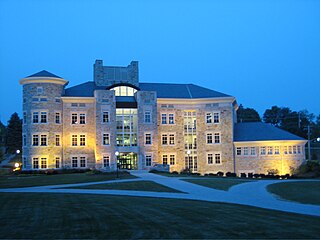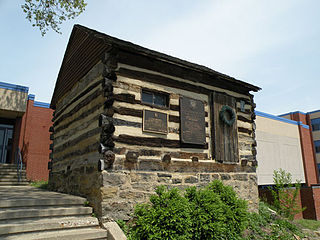
Washington & Jefferson College is a private liberal arts college in Washington, Pennsylvania, United States. The college traces its origin to three Presbyterian missionaries in the 1780s: John McMillan, Thaddeus Dod, and Joseph Smith. Early schools grew into two competing academies, with Jefferson College in Canonsburg, Pennsylvania, and Washington College in Washington. The two colleges merged in 1865 to form Washington & Jefferson College. The 60-acre (24 ha) campus has more than 40 buildings, with the oldest dating to 1793. The college has a strong history of competing literary societies, dating back before the union of Jefferson and Washington Colleges. The athletic program competes in NCAA Division III. Nearly all students live on campus and roughly one-third are members of fraternities or sororities.
Alberto Vilar, a.k.a. Albert Vilar was an American investment manager who became particularly known as a patron of opera companies, performing arts organizations, and educational institutions. Following the collapse of his investment firm, Amerindo Investment Advisors, he was tried and convicted in November 2008 on charges of money laundering, investment advisor fraud, securities fraud, mail and wire fraud. He was sentenced in February 2010 to nine years in prison and released in 2018.

Brian Christopher Mitchell is the president and managing principal of Academic Innovators. Prior to founding Academic Innovators, he served as president of Brian Mitchell & Associates, LLC. He was previously the president of Bucknell University, serving from 2004 until 2010. From 1998 through 2004, he served as president of Washington & Jefferson College. He is a nationally recognized expert in higher education, especially on private higher education.

The University of Pittsburgh at Bradford is a state-related college in Bradford Township, McKean County, Pennsylvania. Founded in 1963, it is a baccalaureate degree-granting, regional campus of the University of Pittsburgh, conferring degrees in over 40 fields of study. In addition to its focus on undergraduate education, the campus hosts multiple research/teaching units of the University of Pittsburgh, including the Center for Rural Health Practice and the Allegheny Institute of Natural History, as well as the Marilyn Horne Museum and Exhibit Center.

University of Pittsburgh at Johnstown is a state-related college in the Johnstown, Pennsylvania area. It is a baccalaureate degree-granting regional campus of the University of Pittsburgh. The university is located in Richland Township, a suburban area near Johnstown city, and was founded in 1927 as one of the first regional campuses of a major university in the United States.
The Pittsburgh Supercomputing Center (PSC) is a high performance computing and networking center founded in 1986 and one of the original five NSF Supercomputing Centers. PSC is a joint effort of Carnegie Mellon University and the University of Pittsburgh in Pittsburgh, Pennsylvania, United States.

WNJR is a non-commercial FM radio station broadcasting a freeform radio format. Licensed to Washington, Pennsylvania, it serves Greater Pittsburgh's Southwest suburbs. The station is owned by Washington & Jefferson College.

The Washington & Jefferson Presidents are the intercollegiate athletic teams for Washington & Jefferson College. The name "Presidents" refers to the two presidential namesakes of the college: George Washington and Thomas Jefferson. W&J is a member of the Presidents' Athletic Conference, the Eastern College Athletic Conference, and play in Division III of the National Collegiate Athletic Association in both men's and women's varsity sports. During the 2005–2006 season, 34 percent of the student body played varsity-level athletics.

The Washington & Jefferson Presidents football team represents Washington & Jefferson College in collegiate level football. The team competes in NCAA Division III and is affiliated with the Presidents' Athletic Conference (PAC). Since its founding in 1890, the team has played their home games at College Field, which was remodeled and renamed Cameron Stadium in 2001.

The University of Pittsburgh Applied Research Center (U-PARC) was a one-million-square foot, high-security research park campus of the University of Pittsburgh. Comprising 53 buildings situated on over 85 acres (0.34 km2), U-PARC is located 14 miles (23 km) from Downtown Pittsburgh in Harmar Township, Pennsylvania adjacent to the Route 28 expressway and Interstate 76, the Pennsylvania Turnpike.
John A. Swanson is an American engineer, entrepreneur, and philanthropist. Swanson is the founder of ANSYS, Inc., a John Fritz Medal winner, and a member of the National Academy of Engineering. He is internationally regarded as an authority and pioneer in the application of finite-element methods to engineering.

The Howard J. Burnett Center, also known as The Burnett Center, is an academic building on the campus of Washington & Jefferson College. This building, named after former President Howard J. Burnett, was completed in 2001 at a cost of $12.8 million. It houses the Departments of Economics and Business, Modern Languages, and Education.
The John A. Swanson Science Center, also known as the Swanson Science Center is an academic building on the campus of Washington & Jefferson College. It was completed in February 2010 and was named after John A. Swanson, an engineer and businessman on the Board of Trustees, who donated $10 million towards its construction. This 47,500 square feet (4,410 m2) facility houses classrooms for Chemistry, Physics, Biophysics and Biochemistry and was designed to match its neighboring historic campus architecture. Its learning facilities include wet and dry teaching laboratories, faculty and student research labs, and a multi-disciplinary lab designed for non-science majors.

The history of Washington & Jefferson College begins with three log cabin colleges established by three frontier clergymen in the 1780s: John McMillan, Thaddeus Dod, and Joseph Smith. The three men, all graduates from the College of New Jersey, came to present-day Washington County to plant churches and spread Presbyterianism to what was then the American frontier beyond the Appalachian Mountains. John McMillan, the most prominent of the three founders because of his strong personality and longevity, came to the area in 1775 and built his log cabin college in 1780 near his church in Chartiers. Thaddeus Dod, known as a keen scholar, built his log cabin college in Lower Ten Mile in 1781. Joseph Smith taught classical studies in his college, called "The Study" at Buffalo.

The relationship between the City of Washington, Pennsylvania, and Washington & Jefferson College spans over two centuries, dating to the founding of both the city and the college in the 1780s. The relationship between the town and college were strong enough that the citizens of Washington offered the college a $50,000 donation in 1869 in a successful attempt to lure the Washington & Jefferson College trustees to select Washington over nearby Canonsburg as the consolidated location of the college. The relationship was strained through the latter half of the 20th century, however, as the college pursued an expansion policy that clashed with the residential neighborhood. The college's frustrations grew after preservationists unsuccessfully attempted to pass laws prohibiting the college from demolishing certain buildings that were listed on the East Washington Historic District. Relations were so bad that residents and college officials engaged in a shouting match at a meeting. Local preservationists also unsuccessfully tried to block the demolition of Hays Hall, which had been condemned.
Joseph DiSarro is an American professor and chair in the Department of Political Science at Washington & Jefferson College. In addition to his teaching duties, DiSarro is chair of the Legal Profession Committee and is the Pre-Law Advisor and Director of the college's Pre-Law Program. He has been pre-law advisor Washington & Jefferson College since 1978, guiding approximately 1,117 students to law school as of 2012. Ken Gormley, Dean of Duquesne University School of Law described DiSarro as "one of the most highly respected pre-law advisors in Pennsylvania."
The Pet House, also known as Monroe Hall, is a residence hall at Washington & Jefferson College that allows students to live with their family pets. It has been identified as part of a growing trend of pet-friendly dormitories across the United States.














